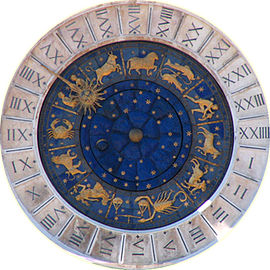占星术和科学
| 占星术 | |||||||||||
|---|---|---|---|---|---|---|---|---|---|---|---|
 | |||||||||||
| 黄道十二宫 | |||||||||||
| 占星术分类 | |||||||||||
| 占星术流派 | |||||||||||
| 占星术使用的行星 | |||||||||||
| 占星术计划 | |||||||||||
占星术由许多不同的信想组成,认为天文现象与人类世界中的事件和人格描述之间存在着关系。占星术因为没有描述宇宙的能力,不被科学界认同。已经进行过对占星术的科学测试,没有证据显示传统的占星术意图支援前述的前提[1]。
每当占星术作出可被证伪的预测时,预测都会被证伪[1]:424。最著名的测试由孝恩·卡尔森领导,委员会的成员包括科学家和占星家。他得出的结论是生日占星的预测没有比机会更好。占星家兼心理学家Michel Gauquelin宣称发现对运动员出生日期的统计支持"火星效应",但在进一步的研究中不能复制它。后继的研究召集人声称Gauquelin曾经建议删除纳入研究的特定个体来试图影响研究的标准。也有人暗示,Geoffrey Dean的出生日期是由父母(在1950年之前)提供的,可能已经造成明显的影响。
Geoffery Dean一项始于1958年、针对2000多名在英国伦敦一带出生且出生时间彼此只差几分钟的人做的长期追踪研究显示,这些人彼此间在性格、职业、智能、焦虑等级、各项技能的能力各方面的表现,皆不相似,而根据占星术的理论,这些人在这些方面应该彼此会非常相似;另外对于700多名占卜师的研究显示,尽管这些占卜师对自己的预测相当有自信,但他们的预测结果并不优于乱猜所得到的结果。[2]
占星术未能证实它在可控制研究的有效性,并且也没有科学有效性[1][3]:85,因此被认定为伪科学 [4][5]:1350。基于生物学和物理学的基本方面,没有行动机制的提议,恒星和行星的位置和运动可能会影响地球上的人和事,但占星家反驳说他们并没有充分的了解[6]:249[7]。
概论
[编辑]大多数职业占星家依靠占星基础对人格测试和完成有关的预测, The majority of professional astrologers rely on performing astrology-based personality tests and making relevant predictions about the remunerator's future. 大多数专业占星家依靠进行 astrology-based 的人格测试, 并对 remunerator 的未来做出相关的预测。 [3]:83。对那些继续相信占星术的人,被描述为”不顾事实,他们的信仰没有经过验证的科学依据,并且实际上有强烈的证据反对[8]。" 天体物理学家奈尔·德葛拉司·泰森对占星术的信仰发表了评论,他说"知道如何思考的一部分是知道自然规律如何塑造我们周围的世界。没有这些知识,没有这种能力,你就很容易成为那些想利用你的人的牺牲品[9]。"
与天文学的历史关系
[编辑]占星术使用的理论结构基础起源于巴比伦人,然而直到经过希腊的亚历山大大帝横扫之后的希腊化时代开始,才被广泛的使用。巴比伦人不知道星座不是在天球上,而且彼此相距甚远。它们邻近的外观是错觉。一个星座的确切分界,是文化,在不同的文化之间有所差异[11]:62。托勒密的天文工作在某种程度上是受到欲望的驱使,就向当时的占星家一样, 很容易计算出行星的运动[12]:40。早期的西方占星术在古希腊的宏观与微观的概念下操作;因此有和天空中的行星和其他天体相关联的医疗占星术产生。这为天文学的研究提供了一些动力[12]:73。虽然一直是进行占星术的实务,托勒密对行星运动和其他天体的预测能力,依然优于占星术的预测[13]:344。
在伊斯兰黄金时代期间,天文学得到资助,使得天文学的参数,像是太阳轨道的离心率、托勒密模型可以计算得到足够的正确性和精密度。那些居高位有权力的人,像是法蒂玛王朝的维齐尔 ,在1120年资助了天文台的建设,以便能在有精确的行星资讯下进行占星的预测[12]:55–56。由于天文台的建立是为了进行占星的预测,但伊斯兰禁占星,所以这些天文台很少能持续很长的时间,大多数都在建筑期间或刚刚建成后就被拆除[12]:57。
在1679年,天文学在工作上开始明确的拒绝占星术,并且每年出版认知[12]:220。不同于西方,在伊朗,在20世纪开始时依然拒绝日心说,部分动机是担心这会破坏占星术和在伊朗普遍信仰的伊斯兰宇宙学 [14]:10。目的在破换这种对占星术和"旧天文学"信仰的第一篇文章,于1861年由Ictizad al-Saltana在Falak al-sa'ada发表。在占星术上,引用了不同的占星家无法对合之后发生的事情做出相同的预测,并且评述占星家将原因归咎于行星的难以置信的属性[14]:17–18。
科学的基本原理
[编辑]相关条目
[编辑]注解
[编辑]参考资料
[编辑]- ^ 1.0 1.1 1.2 Zarka, Philippe. Astronomy and astrology. Proceedings of the International Astronomical Union. 2011, 5 (S260): 420–425. doi:10.1017/S1743921311002602.
- ^ 存档副本. [2019-04-05]. (原始内容存档于2019-05-02).
- ^ 3.0 3.1 Bennett, Jeffrey; Donohue, Megan; Schneider, Nicholas; Voit, Mark. The cosmic perspective 4th. San Francisco, CA: Pearson/Addison-Wesley. 2007: 82–84. ISBN 0-8053-9283-1.
- ^ Hansson, Sven Ove; Zalta, Edward N. Science and Pseudo-Science. Stanford Encyclopedia of Philosophy. [6 July 2012]. (原始内容存档于2015-09-05).
- Astronomical Pseudo-Science: A Skeptic's Resource List. Astronomical Society of the Pacific. [2017-11-11]. (原始内容存档于2011-12-30).
- ^ Hartmann, P; Reuter, M.; Nyborga, H. The relationship between date of birth and individual differences in personality and general intelligence: A large-scale study. Personality and Individual Differences. May 2006, 40 (7): 1349–1362. doi:10.1016/j.paid.2005.11.017.
To optimise the chances of finding even remote relationships between date of birth and individual differences in personality and intelligence we further applied two different strategies. The first one was based on the common chronological concept of time (e.g. month of birth and season of birth). The second strategy was based on the (pseudo-scientific) concept of astrology (e.g. Sun Signs, The Elements, and astrological gender), as discussed in the book Astrology: Science or superstition? by Eysenck and Nias (1982).
- ^ Vishveshwara, S.K.; Biswas, D.C.V.; Mallik, C.V. (编). Cosmic perspectives : essays dedicated to the memory of M.K.V. Bappu 1. publ. Cambridge [England]: Cambridge University Press. 1989. ISBN 0-521-34354-2.
- ^ Peter D. Asquith (编). Proceedings of the Biennial Meeting of the Philosophy of Science Association, vol. 1. Dordrecht u.a.: Reidel u.a. 1978 [2017-11-11]. ISBN 978-0-917586-05-7. (原始内容存档于2008-12-01).
- Chapter 7: Science and Technology: Public Attitudes and Understanding. science and engineering indicators 2006. National Science Foundation. [28 July 2012]. (原始内容存档于2011-12-30).
About three-fourths of Americans hold at least one pseudoscientific belief; i.e., they believed in at least 1 of the 10 survey items[29]" ..." Those 10 items were extrasensory perception (ESP), that houses can be haunted, ghosts/that spirits of dead people can come back in certain places/situations, telepathy/communication between minds without using traditional senses, clairvoyance/the power of the mind to know the past and predict the future, astrology/that the position of the stars and planets can affect people's lives, that people can communicate mentally with someone who has died, witches, reincarnation/the rebirth of the soul in a new body after death, and channeling/allowing a "spirit-being" to temporarily assume control of a body.
- Chapter 7: Science and Technology: Public Attitudes and Understanding. science and engineering indicators 2006. National Science Foundation. [28 July 2012]. (原始内容存档于2011-12-30).
- ^ Objections to Astrology: A Statement by 186 Leading Scientists. The Humanist, September/October 1975. [2017-11-11]. (原始内容存档于2009-03-18).
- The Humanist, volume 36, no.5 (1976).
- Bok, Bart J.; Lawrence E. Jerome; Paul Kurtz. Objections to Astrology: A Statement by 186 Leading Scientists. Patrick Grim (编). Philosophy of Science and the Occult. Albany: State University of New York Press. 1982: 14–18. ISBN 0-87395-572-2.
- ^ Ariz. Astrology School Accredited. The Washington Post. 27 August 2001 [2017-11-11]. (原始内容存档于2019-01-06).
- ^ Allum, Nick. What Makes Some People Think Astrology Is Scientific?. Science Communication. 13 December 2010, 33 (3): 341–366 [2017-11-11]. doi:10.1177/1075547010389819. (原始内容存档于2016-12-02).
This underlies the "Barnum effect". Named after the 19th-century showman Phineas T. Barnum, whose circus act provided "a little something for everyone", it refers to the idea that people believe a statement about their personality that is vague or trivial if they think that it derives from some systematic procedure tailored especially for them (Dickson & Kelly, 1985; Furnham & Schofield, 1987; Rogers & Soule, 2009; Wyman & Vyse, 2008). For example, the more birth detail is used in an astrological prediction or horoscope, the more credulous people tend to be (Furnham, 1991). However, confirmation bias means that people do not tend to pay attention to other information that might disconfirm the credibility of the predictions.
- ^ Pigliucci, Massimo. Nonsense on stilts : how to tell science from bunk [Online-Ausg.]. Chicago: University of Chicago Press. 2010. ISBN 9780226667850.
- ^ 12.0 12.1 12.2 12.3 12.4 Hoskin, Michael (编). The Cambridge concise history of astronomy Printing 2003. Cambridge: Cambridge University Press. 2003. ISBN 0521572916.
- ^ Evans, James. The history & practice of ancient astronomy. New York: Oxford Univ. Press. 1998. ISBN 9780195095395.
- ^ 14.0 14.1 Arjomand, Kamran. The Emergence of Scientific Modernity in Iran: Controversies Surrounding Astrology and Modern Astronomy in the Mid-Nineteenth Century. Iranian Studies (Taylor and Francis, for the International Society for Iranian Studies). 1997, 30: 5–24. doi:10.1080/00210869708701857.
引用错误:在<references>标签中name属性为“NSFIndicators”的参考文献没有在文中使用
引用错误:在<references>标签中name属性为“Raymond”的参考文献没有在文中使用
引用错误:在<references>标签中name属性为“Paul”的参考文献没有在文中使用
引用错误:在<references>标签中name属性为“PopperStanford”的参考文献没有在文中使用
引用错误:在<references>标签中name属性为“Cogan”的参考文献没有在文中使用
引用错误:在<references>标签中name属性为“Eysenck1982”的参考文献没有在文中使用
引用错误:在<references>标签中name属性为“Gonzalez”的参考文献没有在文中使用
引用错误:在<references>标签中name属性为“Rogers”的参考文献没有在文中使用
引用错误:在<references>标签中name属性为“Wunder”的参考文献没有在文中使用
引用错误:在<references>标签中name属性为“Popper”的参考文献没有在文中使用
引用错误:在<references>标签中name属性为“CharpakObit”的参考文献没有在文中使用
引用错误:在<references>标签中name属性为“Charpak”的参考文献没有在文中使用
引用错误:在<references>标签中name属性为“Hawking”的参考文献没有在文中使用
引用错误:在<references>标签中name属性为“ChrisFrench”的参考文献没有在文中使用
引用错误:在<references>标签中name属性为“SundayTimes”的参考文献没有在文中使用
引用错误:在<references>标签中name属性为“Shermer”的参考文献没有在文中使用
引用错误:在<references>标签中name属性为“FailToPredict”的参考文献没有在文中使用
引用错误:在<references>标签中name属性为“Geoffrey”的参考文献没有在文中使用
引用错误:在<references>标签中name属性为“Samuels”的参考文献没有在文中使用
引用错误:在<references>标签中name属性为“Benski”的参考文献没有在文中使用
引用错误:在<references>标签中name属性为“Carroll”的参考文献没有在文中使用
引用错误:在<references>标签中name属性为“Pont”的参考文献没有在文中使用
引用错误:在<references>标签中name属性为“Gauquelin-1955”的参考文献没有在文中使用
引用错误:在<references>标签中name属性为“Carlson”的参考文献没有在文中使用
引用错误:在<references>标签中name属性为“Adorno”的参考文献没有在文中使用
引用错误:在<references>标签中name属性为“Nederman”的参考文献没有在文中使用
引用错误:在<references>标签中name属性为“CritThink”的参考文献没有在文中使用
引用错误:在<references>标签中name属性为“Muller”的参考文献没有在文中使用
引用错误:在<references>标签中name属性为“Kuhn”的参考文献没有在文中使用
引用错误:在<references>标签中name属性为“Wright”的参考文献没有在文中使用
引用错误:在<references>标签中name属性为“Thagard”的参考文献没有在文中使用
引用错误:在<references>标签中name属性为“Hurley”的参考文献没有在文中使用
引用错误:在<references>标签中name属性为“EdwardJ”的参考文献没有在文中使用
引用错误:在<references>标签中name属性为“BMJ”的参考文献没有在文中使用
引用错误:在<references>标签中name属性为“MartinRobbins”的参考文献没有在文中使用
<references>标签中name属性为“Philo”的参考文献没有在文中使用外部链接
[编辑]- Astrology & Science: The Scientific Exploration of Astrology(页面存档备份,存于互联网档案馆)
- Merrifield, Michael. Right Ascension & Declination. Sixty Symbols. Brady Haran for the University of Nottingham. [2017-11-11]. (原始内容存档于2020-07-05).—which also discusses ascension and declination errors in different systems of astrology

